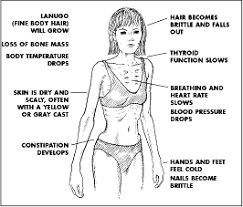Guidance and Support for Identifying Eating Issues
Identifying eating issues
A guide for how to spot early signs of eating issues in children and young people
Examples of how a young person with eating issues may present
During adolescence, young people often experience sudden variations in height and weight. For example, girls can gain an average of 40 pounds (lb.) from age 11 to 14 and that’s normal.
A girl or boy who puts on weight before having a growth spurt in height may look plump, while a student who grows taller but not heavier may appear rather thin.

The points outlined are not necessarily definitive signs or symptoms of issues with eating, only an expert can make that diagnosis.
- Changes in attitude/performance.
- Expresses body image complaints/ concerns: being too fat even though normal or thin; unable to accept compliments; mood affected by thoughts about appearance; constantly comparing self to others; self-disparaging; referring to self as fat, gross, ugly; overestimates body size; strives to create a “perfect” image; seeks constant outside reassurance about looks.
- Incessant talk about food, weight, shape, exercise, cooking, etc.
- Starting to become rigid or obsessively thinking about food, eating, exercise, labels foods as good/bad; on/off limits for no actual reason; appears uncomfortable or unwilling to share food; inflexible about diet without reason.
- Appears sad/depressed/anxious/ashamed/embarrassed/expresses feelings of worthlessness.
- Emotions are flat or absent.
- Intolerance for imperfections in academics, eating, social life, etc.
- Is the target of body or weight bullying currently or in the past.
- Spends increasing amounts of time alone; pulls back from friends.
- Is obsessed with maintaining unhealthy eating habits to enhance performance in sports, dance, acting, or modelling.
- Overvalues self-sufficiency; reluctant to ask for help.
- Unable or unwilling to acknowledge recent changes.
Physical
- Sudden weight loss, gain, or fluctuation in a short time.
- Complaints of abdominal pain.
- Feeling full or “bloated”.
- Feeling faint, cold, or tired.
- Dark circles under the eyes or bloodshot eyes/ burst capillaries around eyes.
- Calluses on the knuckles from self-induced vomiting.
- Dry hair or skin, dehydration, blue hands/feet.
- Lanugo hair (fine body hair).
- Fainting or dizziness upon standing; frequent fatigue.
- Thinning, dry hair.

Behavioural
- Diets or chaotic food intake; pretends to eat, then throws away food; skips meals.
- Creates rigid dietary rules or observes strict diet without medical or religious reasons.
- Exercises for long periods and with an obsessional attitude; exercises excessively every day (can’t miss a day).
- Constantly talks about food; unwilling to share food; hoards food; refuses to eat food prepared by others or without knowing exact ingredients.
- Difficulty sitting still: hovers over a chair instead of sitting, constantly jiggles legs, gets up from the desk at every opportunity, and offers to run errands.
- Makes frequent trips to the bathroom.
- Makes lists of foods and calories eaten.
- Wears very baggy clothes to hide a very thin body (anorexia) or weight gain (binge eating disorder) or to hide a “normal” body because of concerns about body shape/size.
- Avoids canteen at school or works through lunch, eats alone.
- Shows some type of compulsive behaviour (e.g., compulsive handwashing; hoarding; repetitive movements/speech; need for constant reassurance).
- Denies difficulty with food or body image despite evidence that it is an area of concern.
If you would like guidance on how to support a young person with an eating disorder, please access the toolkit on the below link:
